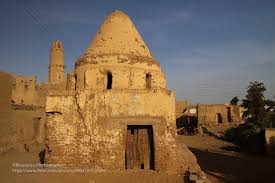A Journey Through Time and Culture: 6 Wonders of Dakhla Oasis
Dakhla Oasis, one of Egypt’s most captivating destinations, offers a blend of stunning natural landscapes and rich historical sites. Situated in the heart of the Western Desert, this oasis holds many archaeological and cultural gems that transport visitors back in time. In this guide, we’ll explore some of the most significant attractions in Dakhla Oasis, including Al-Qasr Village, The Temple of Dush, Paris Village, The Archaeological Site of Deir El-Hagar, The Dakhla Oasis Museum, and Al Muzawaka. These places not only reveal the ancient history of Egypt but also showcase the harmonious coexistence of the desert’s beauty and the region’s unique heritage.
Al-Qasr Village: A Walk Through History
Al-Qasr is often referred to as the crown jewel of Dakhla Oasis. This ancient village dates back to the medieval era and is known for its remarkable preservation. The village is a fine example of traditional mudbrick architecture, offering an authentic glimpse into the lives of the people who once inhabited the oasis.
Strolling through Al-Qasr feels like a walk through a living museum. The village is laid out on the slopes of a hill and is filled with narrow, winding alleys that lead to residential homes, mosques, and markets. The homes are made of mudbrick and feature simple yet functional designs that have stood the test of time. The Qasr Mosque, with its unique structure, is a highlight, with intricate carvings on its walls and a blend of Islamic and traditional architectural styles.
At the heart of Al-Qasr, you will also find the remains of ancient fortifications, which tell the story of the village’s strategic importance throughout history. Visitors can experience the local culture, interact with residents, and witness how people have lived in harmony with the desert for centuries.
Mujawara
Mujawara is a quaint and charming area located near the Dakhla Oasis. It’s a fantastic spot for anyone interested in the history of the ancient caravan trade. The village is home to several archaeological remnants, including old tombs, wells, and ruins that give visitors a sense of what life was like in the Oasis centuries ago. Mujawara is also known for its traditional mudbrick buildings and the beautiful contrast between the green palm trees and the surrounding desert.
Paris Village: The Hidden Gem of the Oasis
Paris Village, also known as Qasr Paris, is one of the lesser-known but equally fascinating sites in Dakhla Oasis. The village is located at the foot of a hill and is named after the French settlers who once inhabited it in the 19th century.
What makes Paris Village so special is its unique blend of architectural styles. The French settlers constructed their homes using a mixture of European and traditional desert architecture, resulting in a striking fusion of styles that reflects the cultural exchange between the French and local Egyptians. Visitors to Paris Village can see the remains of these homes, which are built with stone and mudbrick, giving them an earthy yet sophisticated appearance.
Though the village was abandoned in the early 20th century, it remains a hidden gem that offers visitors an intimate look at the colonial history of Dakhla Oasis. The nearby landscapes of the oasis, with their expansive date palms and rugged terrain, provide a picturesque setting for exploration.
The Archaeological Site of Deir El-Hagar: A Roman Temple in the Desert
The Deir El-Hagar temple, located about 2 km from the village of the same name, is one of the most impressive Roman temples in Egypt. Dedicated to the god Amun Ra, the temple dates back to the 1st and 2nd centuries AD and is one of the best-preserved monuments in Dakhla Oasis.
What makes Deir El-Hagar particularly unique is its isolated location in the desert, which has helped protect it from modern development. The temple is built using sandstone, and its walls are adorned with well-preserved carvings and inscriptions that depict the gods of ancient Egypt. These carvings illustrate the fusion of Egyptian and Roman religious practices during the period of Roman rule in Egypt.
Visitors can explore the ruins of the temple, its massive columns, and the surrounding courtyard. The peaceful desert surroundings enhance the sense of awe and mystery that surrounds this ancient site, making it a must-see for history enthusiasts.
The Dakhla Oasis Museum: A Deep Dive into the Region’s Heritage
For those looking to learn more about the history and culture of Dakhla Oasis, the Dakhla Oasis Museum is an essential stop. Located in the heart of the modern town of Dakhla, this museum offers a comprehensive overview of the oasis’s rich past, from prehistoric times to the Islamic era.
The museum’s exhibits include ancient artifacts, pottery, tools, and textiles discovered in the region, many of which date back to Pharaonic and Roman times. Visitors can also see displays of traditional handicrafts and everyday items used by the local Bedouin communities, showcasing how the people of the oasis have adapted to the harsh desert environment.
In addition to its archaeological exhibits, the museum offers insights into the cultural significance of the oasis and its role in trade, religion, and daily life throughout history.
Al Muzawaka: The Painted Tombs of the Western Desert
One of the most fascinating and lesser-known sites in Dakhla Oasis is Al Muzawaka, an ancient burial site located about 3 km from the modern town of Dakhla. Al Muzawaka is famous for its painted tombs, which date back to the Ptolemaic and Roman periods.
The tombs are carved into the rock, and the walls are adorned with vibrant frescoes that depict scenes of daily life, gods, and animals. The intricate paintings offer a rare glimpse into the beliefs and customs of the ancient inhabitants of Dakhla. These tombs were created for local officials and their families, and the vivid colors of the murals have been remarkably well-preserved despite the passage of time.
Al Muzawaka is one of the most unique burial sites in Egypt, and visiting it offers a chance to see art that has survived for over two millennia, as well as learn about the spiritual practices of the region’s ancient peoples.
Conclusion
Dakhla Oasis is a treasure trove of history, culture, and natural beauty, and the sites outlined above provide a fascinating look into the past of this remote Egyptian oasis. Whether you’re exploring ancient temples like Deir El-Hagar, wandering through the medieval streets of Al-Qasr Village, or admiring the painted tombs at Al Muzawaka, each site offers a unique story that showcases the rich heritage of Dakhla. This oasis is a must-visit destination for anyone looking to uncover the secrets of Egypt’s desert landscapes and ancient civilizations.
Pack your bags, put on your adventurous spirit, and embark on a journey to explore the hidden gems of Dakhla Oasis!


